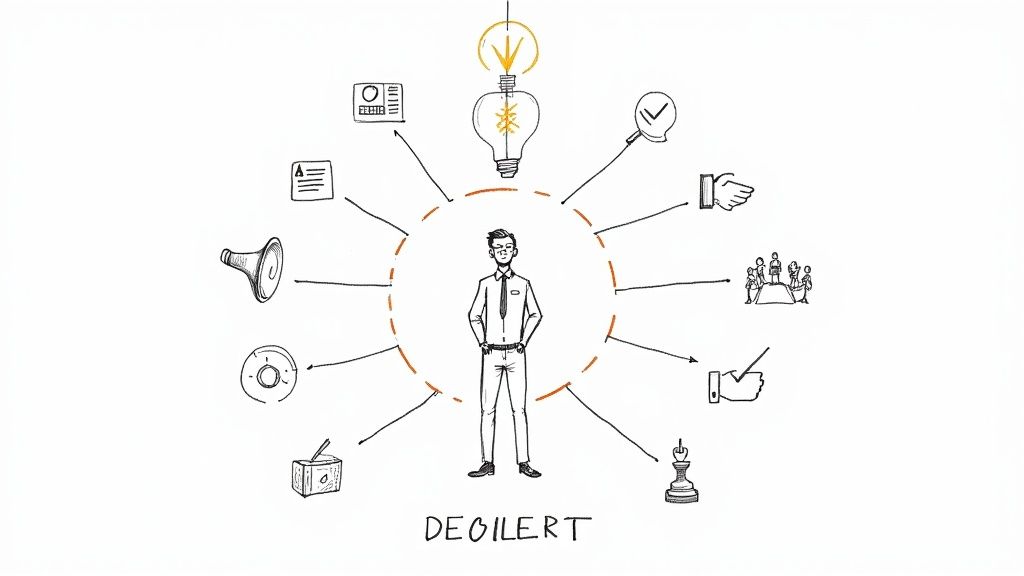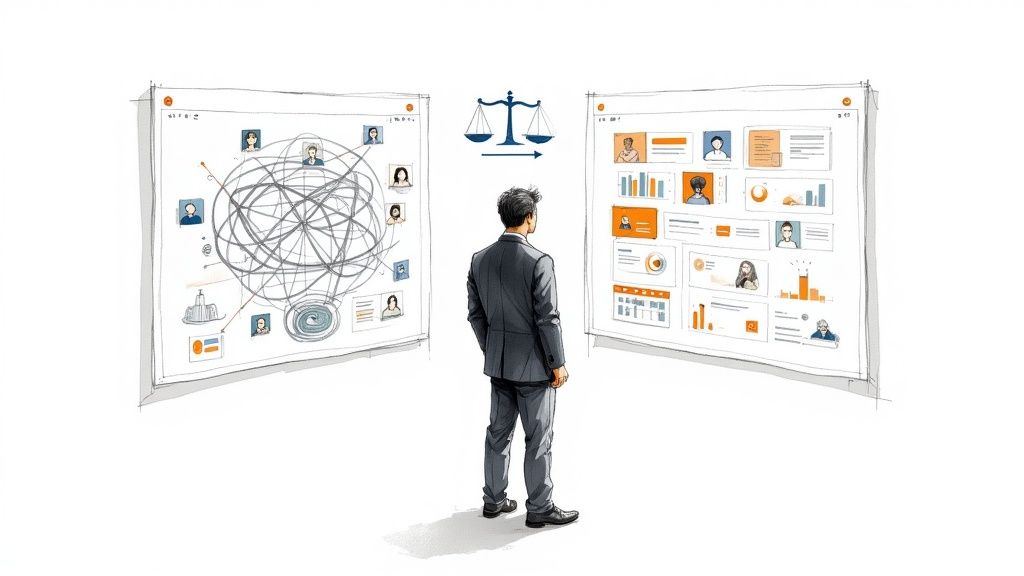We've all been there. You walk out of an interview with a really good feeling about a candidate. It’s tempting to rely on that instinct, but let’s be honest—it’s a risky foundation for building a truly great team. An interview evaluation form template is your most powerful tool for moving beyond subjective guesswork and into a consistent, data-driven hiring process.
Why Gut Feelings Are Costing You Great Hires
We often want to trust our intuition. But what if that "good feeling" is just a reflection of our own unconscious bias? What if it's inconsistent from one day to the next? The real-world costs of purely subjective hiring are steep, from high turnover rates to a frustrating lack of diversity on your team. It’s a flawed approach that leaves far too much to chance.
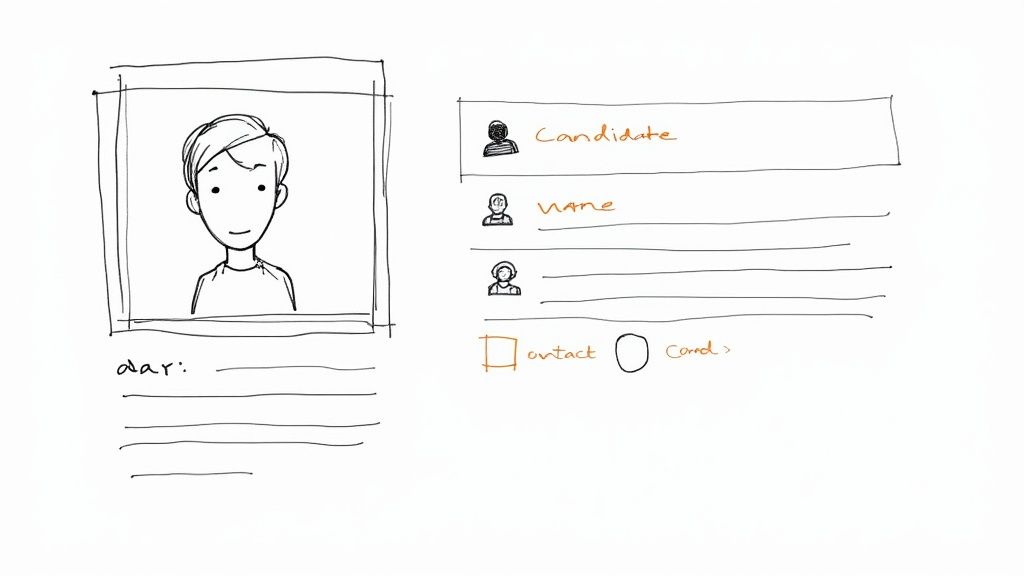
This is where a structured process becomes non-negotiable. Using a standardized form for every interview isn't just about ticking boxes; it's about bringing objectivity and fairness to the forefront. When every candidate is measured against the same criteria, you level the playing field and dramatically reduce the impact of personal bias. This consistency allows you to compare apples to apples, making your final decision much clearer and more defensible.
From Guesswork to a Data-Driven System
Implementing a standardized evaluation form fundamentally shifts your hiring process from hoping for the best to a structured system built on evidence. This isn't just about fairness, though that's a huge part of it. It’s also about creating a legally sound and defensible hiring practice. Think of it as a strategic framework for finding—and keeping—quality talent.
A great hire is rarely an accident. It's the result of a structured process where evidence outweighs emotion. Using an interview evaluation form is the first step in building that process.
When you start documenting feedback against predefined criteria, you build a powerful record. This data not only helps you compare candidates for the current opening but also reveals valuable patterns over time. You might discover that candidates who score high on "problem-solving" consistently become top performers in your company. Now that's an insight you can use.
This structured approach is even more critical for specialized roles. For instance, learning how to hire salespeople effectively often comes down to a methodical evaluation process that can directly predict who will build a high-performing revenue engine. It’s all about finding talent that genuinely fits the role and aligns with your company’s long-term goals.
How To Build Your Custom Evaluation Template
Ditching the generic, one-size-fits-all approach is your first real step toward a more insightful evaluation process. Let's be honest: a truly effective interview scorecard isn't just another piece of paper to be filed away. It's a powerful tool built specifically for the role you’re hiring for and the unique culture of your company.
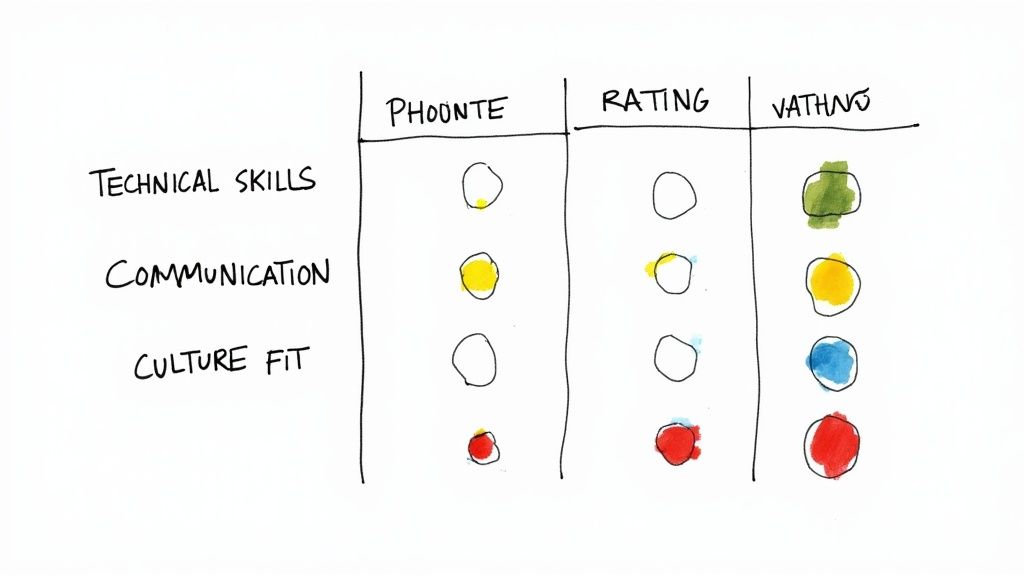
The foundation of any great custom form is a crystal-clear distinction between core company competencies and role-specific skills. Core competencies are the non-negotiables—the traits every single employee should have, like "Adaptability" or "Collaboration." Role-specific skills, on the other hand, are the technical or functional chops needed for that particular job.
Differentiating Core And Role-Specific Skills
Think about a core competency like "Collaboration." This looks wildly different from one role to the next, and your form absolutely must reflect that nuance.
- For a Graphic Designer: You might evaluate collaboration by asking how they've handled and incorporated feedback from non-creative stakeholders into a project.
- For a Sales Lead: That same competency is measured by their ability to partner with the marketing team on lead-gen campaigns or ensure smooth customer handoffs with account managers.
Your form needs separate, dedicated sections for these different criteria. This simple act of organization prevents you from trying to measure a developer's sales instincts or a salesperson's coding prowess. It keeps the evaluation laser-focused and relevant. For a more detailed breakdown, our complete guide to building an https://asyncinterview.io/post/interview-evaluation-form/ offers more in-depth examples.
An effective evaluation form doesn't just ask if a candidate has a skill; it provides a framework to uncover how they've demonstrated it in situations relevant to your business needs.
Crafting Questions That Reveal Potential
Once you've defined what you're looking for, the next move is to write behavioral questions that get candidates talking about specific examples from their past. Vague questions will always get you vague, unhelpful answers. So, instead of asking something generic like, "Are you a good problem-solver?", you need to get more targeted.
Try this instead: "Describe a time you ran into an unexpected technical roadblock on a project. What were the exact steps you took to diagnose the problem, and what was the final outcome?"
This kind of question forces a candidate to provide concrete proof of their skills. It shifts the conversation from hypotheticals to real-world application, which is where you find out what someone can really do.
Many of the same principles of structuring information apply across different types of business forms. If you're interested in going deeper on the art of information gathering, you might find valuable insights in resources covering mastering intake form template design. Building a solid library of these targeted questions for each competency will make your custom interview evaluation form an indispensable part of your hiring toolkit.
Designing a Scoring System That Drives Decisions
Let’s be honest, the rating scale is the real engine of your interview evaluation form. If it’s poorly designed, it just creates more confusion than clarity. The whole point is to move your hiring team away from vague, gut feelings and give them a solid tool for making consistent, evidence-based decisions.
Without clear definitions for your scores, one interviewer’s "good" is another's "average," and suddenly, all that data you’ve collected is pretty much useless.
The most common starting point is a simple numerical scale, like 1-5. It's straightforward, but its true power comes from the descriptive anchors you tie to each number. Vague labels are the enemy here.
Defining Your Rating Scale
Instead of just slapping numbers on the page, pair them with clear, behavior-based descriptions. This is critical for making sure every single interviewer is using the same yardstick to measure a candidate’s answers.
Here's a simple, effective example:
- 1 – Needs Development: The candidate showed little to no real evidence of this skill and couldn't provide relevant examples when prompted.
- 3 – Meets Expectations: The candidate demonstrated a solid grasp of the skill and gave adequate examples that line up with what the role requires.
- 5 – Exceeds Expectations: The candidate offered multiple, compelling examples of this skill. They showcased a deep, almost strategic understanding that goes well beyond the basic job requirements.
A well-defined scoring system is less about the numbers themselves and more about creating a shared language for what excellence actually looks like at your company. This alignment is what turns a bunch of individual opinions into a collective, data-backed hiring decision.
Comparison of Interview Rating Scales
Choosing the right scale can feel tricky. A 1-5 scale is common, but it's not the only option. To help you decide, here’s a quick breakdown of the most common rating scales, their pros, and their cons.
| Scale Type | Pros | Cons | Best For |
|---|---|---|---|
| Numerical (1-5) | Simple, easy to average scores, widely understood. | Can be subjective without clear anchors; risk of "central tendency" where interviewers avoid high/low scores. | Most general roles; teams that need a quick, quantifiable way to compare candidates. |
| Likert Scale | More descriptive (e.g., Strongly Disagree to Strongly Agree). Provides nuanced feedback on specific statements. | Can be more time-consuming to complete. Requires carefully worded statements. | Assessing culture fit, values alignment, or specific behavioral traits. |
| Behaviorally Anchored Rating Scale (BARS) | Extremely detailed and objective. Uses specific behavioral examples for each point on the scale. | Time-intensive to create and requires significant upfront research. | Highly specialized or senior roles where specific, critical behaviors determine success. |
| Pass/Fail | Fast and decisive. Eliminates ambiguity. | Lacks any nuance. Doesn't differentiate between a great candidate and an acceptable one. | Screening for non-negotiable "knockout" criteria, like a specific certification or technical skill. |
Ultimately, the best scale is the one your team will actually use consistently. Start simple if you have to, and get more detailed as your hiring process matures.
This chart is a great example of how you can visualize the data you collect. It quickly shows where your candidate pool is strong and where there might be weaknesses.
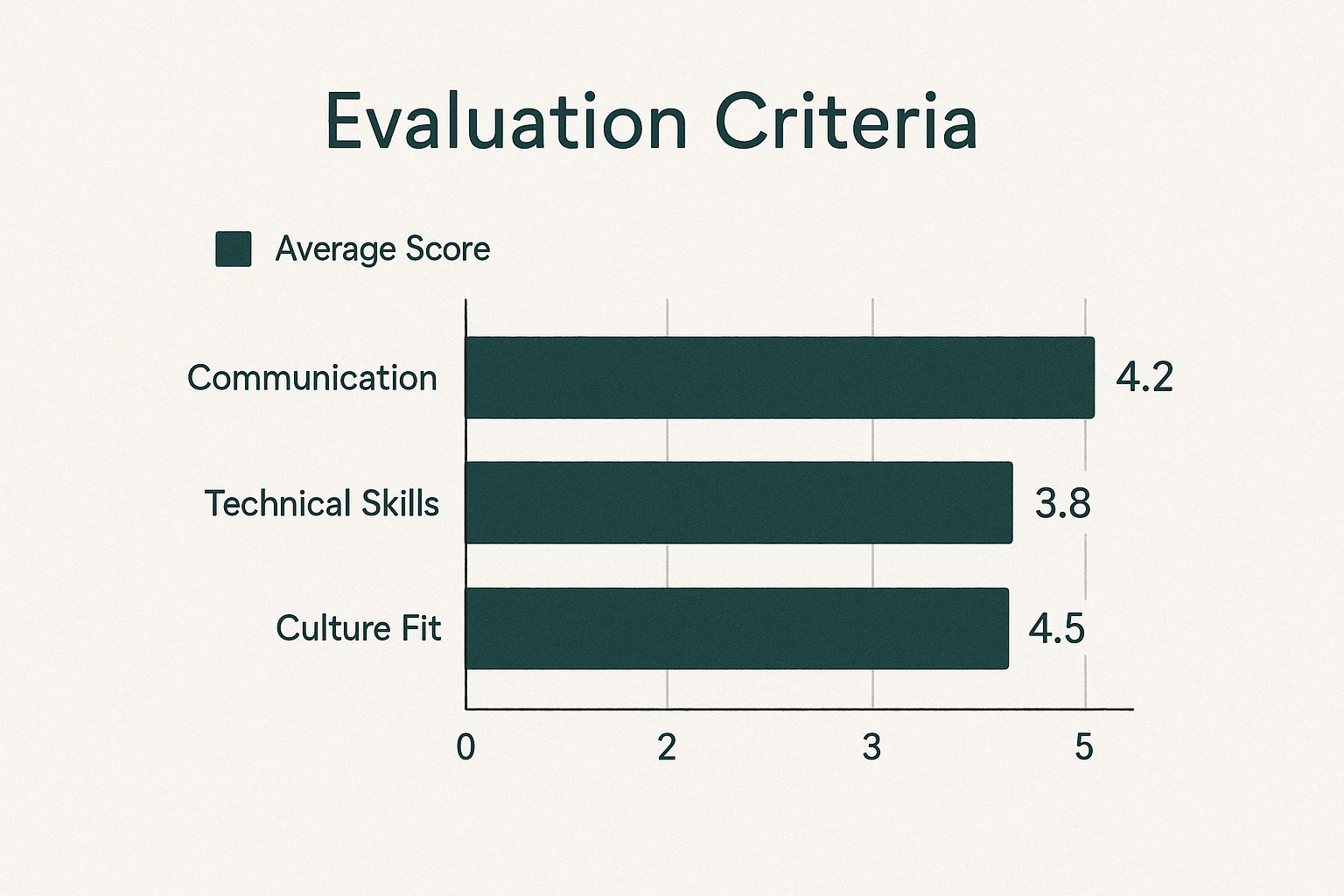
From a quick glance at this visual, it's clear that while candidates are doing well in communication and culture fit, technical skills might be a gap you need to dig into during the debrief meetings.
As a final tip, consider adding a "Red Flag" option for any show-stopping concerns and a "Not Applicable" (N/A) choice. The N/A is perfect for skills that just don't come up in a particular interview stage, keeping your data clean.
Putting Your Evaluation Form Into Practice
A beautifully designed interview evaluation form is only half the battle. Its real power comes alive when you put it into practice consistently across your entire hiring team. This is where the rubber meets the road—where theory collides with the reality of back-to-back interviews and busy schedules.
Getting the implementation right is what separates a good hiring process from a great one.
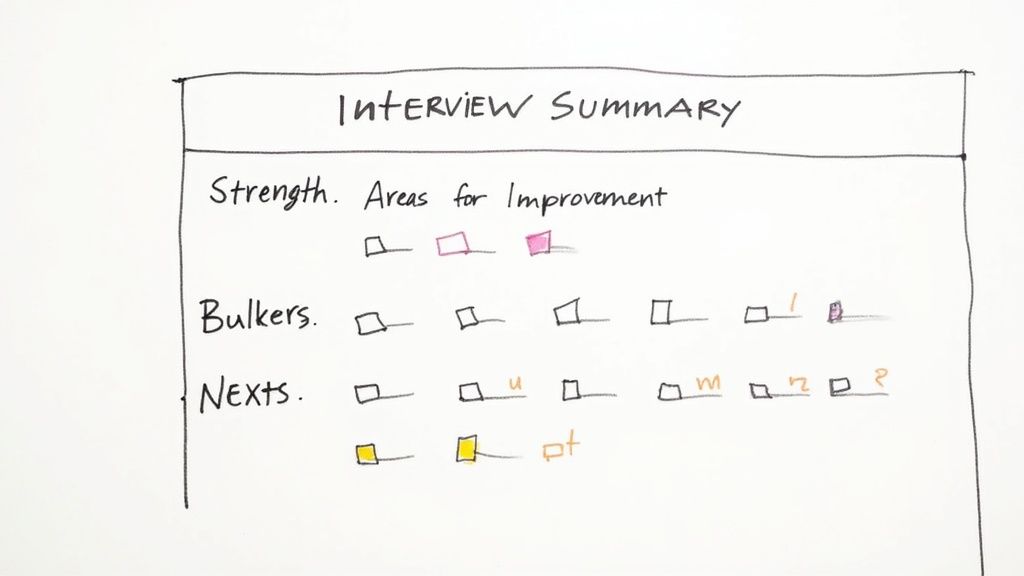
Before a single candidate walks through the door, you need to schedule a pre-interview calibration meeting. This is, without a doubt, the most important 30 minutes you can spend.
In this session, the entire hiring panel gets together to review the form. You’ll go through each competency and agree on exactly what a "Meets Expectations" or a "Strongly Exceeds" score actually looks like for this specific role. This simple meeting ensures every interviewer is scoring from the same playbook, which drastically cuts down on mismatched ratings and bias.
From Conversation to Concrete Evidence
During the interview itself, the goal isn't just to have a good chat. It's to gather proof. Train your interviewers to ditch vague, subjective notes and instead capture specific, behavior-based evidence that ties directly back to the competencies on the form.
- Weak Note: "Good communicator."
- Strong Note: "Clearly explained a past project conflict using the STAR method; maintained good eye contact and paused to let others speak."
This one change transforms your form from a basic checklist into a powerful repository of evidence.
Then, immediately after the interview wraps up, each interviewer must complete their evaluation independently. Don't wait. Even a few hours can blur the details and let personal feelings creep back in, undermining the whole process.
Your completed forms become the anchor for your debrief meeting. They ground the conversation in objective data, not just feelings. When someone says, "I just got a really good vibe," the team can now ask, "What specific evidence did you see that supports that?"
This disciplined approach ensures your hiring decisions are built on a solid foundation of documented, comparable evidence. You'll move the final discussion away from "who did we like?" and toward "who demonstrated the skills we need?"—leading to hires you can stand behind with total confidence.
Weaving Your Form into Modern Hiring Tech
An interview evaluation form is a solid tool on its own, but its real power is unleashed when you plug it into modern hiring technology. When you connect your digital forms with the tools you already use, you can automate data collection, spot trends across all your candidates, and finally free your team from soul-crushing manual entry. This is how you turn static feedback into dynamic, actionable data.
To really scale this up, think about integrating your forms with something like an Applicant Tracking Systems. An ATS acts as your central command hub, automatically attaching every completed evaluation to the right candidate profile. Suddenly, you have a single, searchable record for every applicant, making those post-interview debriefs and future reference checks incredibly efficient.
The Rise of AI and Automation
Artificial intelligence is also completely changing how we use evaluation data. It’s not just a buzzword anymore. In fact, recent data shows that 63% of hiring managers say AI and automation have fundamentally changed how they conduct interviews. This isn't about robots taking over; it's about using specialized tools to analyze responses from your forms to pull out deeper insights into a candidate's skills and even their attitude.
Of course, it’s all about striking the right balance. Technology should support your team's judgment, not replace it.
Technology is a powerful assistant, not the final decision-maker. Use AI for insights and automation for efficiency, but preserve the critical human judgment needed to make the right hire. The goal is a smarter, faster process, not a robotic one.
This approach ensures you gain efficiency without losing that essential human touch. For a closer look at getting this balance right, our guide on the principles of automated candidate screening is a great place to start.
Ultimately, the best systems use tech to handle the repetitive, tedious work. This empowers your team to focus on what they do best: making a thoughtful, well-informed hiring decision.
Common Questions About Evaluation Forms
Switching to a standardized hiring process always brings up a few questions. That’s totally normal. When you're rolling out something as important as an interview evaluation form template, which fundamentally changes how your team makes decisions, you want to get it right. Let's walk through some of the most common hurdles and concerns I see managers run into.
How Do We Make Sure Our Form Is Fair And Legal?
This is the big one, and the answer is surprisingly straightforward. To keep things fair and legally sound, every single evaluation criterion must tie directly back to the essential skills and functions you laid out in the job description. This is your north star—it's non-negotiable.
It goes without saying, but you have to steer clear of any questions or criteria touching on protected characteristics like age, race, or gender. The real key, though, is standardization. You have to use the exact same form and scoring guide for every single candidate in the running for that role. Consistent training for all your interviewers on how to use the form is your single best defense against both unconscious bias and potential legal challenges.
What Is The Best Way To Train Managers On The Template?
Whatever you do, don't just email the new template and hope for the best. That’s a recipe for inconsistent results. The only way to do this effectively is to get your interviewers in a room for a hands-on training session. Go through the form section by section, and don't move on until everyone understands what each competency means and what each point on the rating scale actually looks like in practice.
The gold standard for this is running a 'calibration session.' Get the whole hiring panel together and have everyone evaluate a mock candidate using the form. This exercise is incredibly powerful for aligning everyone's scoring. It ensures a "4 – Exceeds Expectations" means the same thing to every single person on the team.
This alignment is what stops one manager's "good" from being another's "average," a situation that would make your data completely useless. Emphasize that interviewers need to take specific, behavior-based notes to justify every single rating they give. For a deeper dive, our detailed post on the candidate evaluation form has even more guidance.
Should We Share Evaluation Feedback With Candidates?
You absolutely should. In fact, you're leaving a massive opportunity on the table if you don't. A 2022 global study found that a staggering 82% of candidates are hungry for more feedback on how they performed in their interviews. You can read more about that in the full interviewing trends report. A structured evaluation form is the perfect tool to help you deliver it.
Now, this doesn't mean you should send them the raw form with all the numerical scores. That’s not helpful. Instead, take a few minutes to synthesize the key takeaways from the evaluation into a thoughtful and constructive feedback summary. You can highlight the strengths they really showcased and maybe gently point out one or two areas where they could focus their development.
Providing this kind of feedback isn't just a "nice-to-have" anymore. It's a critical piece of a positive candidate experience and a powerful way to build up your employer brand, even with the people you don't end up hiring.
Ready to stop relying on gut feelings and start making data-driven hiring decisions? Async Interview helps you streamline your entire process with powerful video interview and evaluation tools. Ditch the scheduling headaches and inconsistent feedback. Get started for free today and see how you can hire better talent, up to 10x faster.


